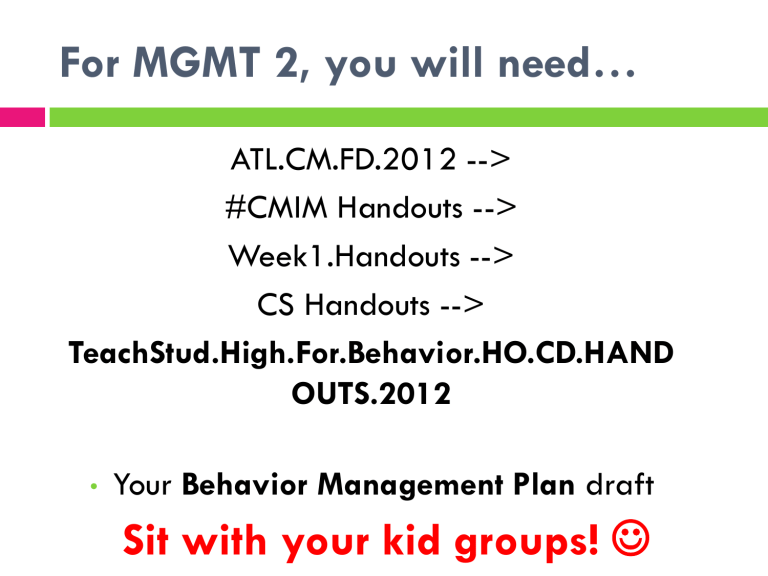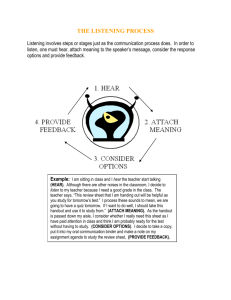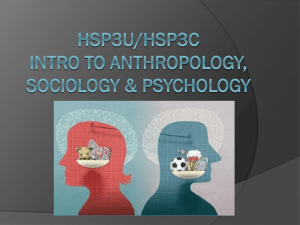MGMT_2_PPT_2012

For MGMT 2, you will need…
ATL.CM.FD.2012 -->
#CMIM Handouts -->
Week1.Handouts -->
CS Handouts -->
TeachStud.High.For.Behavior.HO.CD.HAND
OUTS.2012
•
Your Behavior Management Plan draft
Sit with your kid groups!
MGMT 2
Teaching Students Your High
Expectations for Behavior
Do Now: Management Quick Quiz
1) True or False? Students WANT and DESERVE a well-managed classroom, and a teacher who cares enough to command it.
2) Who controls how students behave in your classroom? __________
3) Which students can behave? __________
4) Complete this definition: Classroom management means __________% compliance from 100% of _________ 100% of the time.
• Bonus: How does this actually lead to students having more autonomy and freedom in your class?
5) Part One: Put the following components of getting to an effectively-managed class in order: a. a well-planned system for management and procedures b. the system is clearly enforced with students c.
the system is clearly communicated to students d. a strong teacher voice/presence in the classroom
Part Three: why are our mindsets about management so important?
Keys to Effective Management
1.
2.
3.
Beliefs:
Classroom management is essential to student achievement.
All students can behave and it’s my responsibility to help them do so.
Even though I’m a new teacher, I can master the actions that lead students to behave responsibly.
Skills:
An effective “teacher voice”
Mini lessons on responsible behavior
Tools:
A strong management plan, customized to the needs of my classroom.
Consider: How will I communicate my management plan to my
Ss so that they understand it and are able to comply?
\
I AM THE
BOSS OF MY
CLASSROOM!
Reviewing MGMT 1
Previewing MGMT 2
7 minutes
Key Points: MGMT 1
How does having a well managed classroom demonstrate that we care about students?
Is it reasonable to expect that all students can behave?
What is the definition of classroom management?
Key Points: MGMT 1
Why is a well managed classroom so critical to student success? How does having a well managed classroom demonstrate that we care about Ss?
Who sets the tone for student behavior in the classroom? Is it reasonable to expect that all Ss can behave?
All if we set high expectations
What is the definition of classroom management?
How does strong classroom management lead to a culture of achievement and engagement?
KP4: Teaching Responsible Behavior
Criteria for Effective Mini-Lessons:
Come soon before behavior is need
Include a short, student-friendly, academic-focused rationale
An objective & 3-4 observable behaviors
Modeling of examples & non- examples
Checks for understanding throughout
Whole class practice
Behavior expectations need to be explicitly taught.
Teaching Ss Responsible Behavior:
Introduction, Modeling, & Practice
46 minutes
Have the following available:
CS- TeachStud.High.ExpHO
• Handout 1 Guided Notes pg 1
• Handout 2 Template pg 2
• Handout 3 Example pg 3
Video Clip: “Testimonials on Teaching Management”
Common Concerns:
1.
2.
3.
4.
Ss should come to class pre-
programmed to behave the way we want them to.
Older Ss should already
know how to behave.
It’s not my job as a teacher to teach behavior.
Isn’t it culturally
disrespectful to expect my
Ss to behave like I did when
I was a student?
Video Clip: “Lee Canter on How to Teach
Responsible Behavior”
As you watch, note the following…
WHAT do I need to teach?
HOW should I teach it?
WHY are the teachers in the clips effective?
Are there other things they could do to be more effective?
Have the following available:
CS- TeachStud.High.ExpHO
• Handout 1 Guided Notes pg 1
Yes, this level of explicitness is necessary.
Process: How to Teach Management
Have the following available:
CS- TeachStud.High.ExpHO
• Handout 2 Template pg. 2
Process: How to Teach Management
Right before your Ss practice a certain behavior, teach a mini lesson:
Step
1. Open with a short, student-friendly, academic-focused rationale for the responsible behavior
2. Tell Ss what the objective of the lesson is
3. Model for them 3-4 observable behaviors (verbal behavior, movement, participation) you want to see.
4. Have several Ss get up and model examples & non-examples of the behavior
5. Ask questions to check for understanding throughout.
Location on Plan
Opening Section
Objective
INM
Modified GP
( not always necessary)
Throughout
6. Have the whole class practice the behavior.
Additional Notes:
5-10 minutes, happens right before expected behavior occurs
GP
Teaching Management at Institute
First Days of School
Teach most essential aspects of Management Plan
Throughout Summer
Re-teach as needed
Teach new Policies & Procedures as they arise
Use mini lesson template as guide
Kid Groups will divide planning/teaching opportunities*
*CMA supported work time this afternoon
Example Mini Lesson: Active Listening Position
1.
Read the mini lesson plan on H3 pg. 3
Discuss w/ a partner.
2.
What are some
strengths of this
Responsible Behavior mini-lesson?
In what ways could it
be made stronger?
If you have time…
3.
In what ways would this mini-lesson need to be
modified for 6 th - 8 th graders?
Handout 3: Responsible Behavior Mini Lesson Example
Mini Lesson Mind Meld
Strengths…
• Simple, clear, meaningful, studentfriendly rationale
• 4 observable behaviors
• Addresses verbal behavior, movement, participation
• Whole-class practices behavior
•
What are the higherlevel than “thumbs-up/thumbs-
• strengths?
• Plan for exact language teacher will use
• Skips small-group modeling (to save time for more complex learning)*
Could be stronger…
• Skips small-group modeling*
• CFUs do not occur throughout minilesson
• CFUs only check some students
Video Clip: “CMs Teaching Responsible
Behavior”
Consider:
WHAT made these minilessons on effective ?
WHAT could these teachers have done even better ?
Handout 1: Guided Notes for Video Instruction
Strengths
Ms. Yang: Specific and observable behaviors for students to follow.
Ms. Baranpuria: Provided rationale for procedure & expectations are visible
Mr. Lundy: Had students model getting quiet during his attention signal
Ms. Carabajal: CFU by asking questions about specific example
Improvements
Mr. Lundy: Should address movement and participation when he gives the attention getting signal ( what to do with hands, looking at teacher)
Ms. Carabajal: CFU could be stronger. Only asked one student, but ends up giving the student most of the answer.
Teaching Responsible Behavior is like the results wear off after a while, and you must do it over and over again for it to be effective!
Rehearsal Protocol: Snappy Practice
Step #1: Watch the exemplar
• What does this skill look like done well?
Step #2: Get clear on the directions
• How will we practice? What skill(s) am I focusing on?
Step #3: Pair practice
• CM#1 acts as teacher; CM#2 observes
• Repeat until time to switch roles
Step #4: Whole group example*
• Watch a peer try this and answer: “What should s/he definitely do again and why? What should s/he consider doing differently and why?
Step #5: Reflection*
• Answer questions: How did I do? What are my next steps?
*Step may sometimes be omitted.
Video Clip for Snappy Practice: “Teaching Active
Listening Position”
Justin Meli – 3 rd Grade
In pairs, practice:
Giving a short, student-friendly, academic-focused rationale
Communicating 3-4 observable behaviors (verbal behavior, movement, participation)
Checking for understanding
Giving Ss an opportunity to practice
Using your strong Teacher Voice
Snappy Practice: Teaching Active Listening Position
When the timer goes off we are automatically going to do something that we call active listening position.
Please put your eyes on me, fold your hands on your desk. Fantastic, this class is doing wonderfully already.
Feet flat on the floor, and your back is straight with your head up, we’re not slumping we’re not leaning sideways.
We’re going to use active listening position a lot because scientists show that when students are sitting in active listening position, that means making eye contact with the person who’s speaking, that means sitting with their hands folded, their back straight and their feet flat on the floor, that that is the position in which you're taking in the most information.
Active listening position is going to be very useful when I’m giving you instructions or when I’m teaching you something new that you’re going to need to do in just a few minutes.
So when I saw active listening position let’s see active listening position.
Share Out and Reflection
Whole Group
•
•
What should s/he definitely do again?
Why?
What should s/he consider doing differently? Why?
Partner Reflection
•
•
How did I do w/ this skill?
What are my next steps?
Clarifying Your Management Plan: Sections
D&E Management Q&A
15 minutes
Management Plan Sections D & E
• 6-8
Management Plan: Responsible Behavior During
Instructional Activities (Section D)
WHAT are they?
Expectations for behavior during regular instructional times
WHY do we have them?
Provides comforting routine
Saves learning time
At Institute
Complete right-hand column w/ 3-4 specific behaviors
What to do, how to do it, cover verbal behavior, movement, & participation, and be observable & specific
Write the way you will present to Ss
Create accompanying visual
Plan the details
From MGMT1, Handout 2: The Collaborative Management Plan
Section D:
Behavior Expectations for Instructional Activities
(p. 189-190)
How is this section different from the rules section we reviewed yesterday?
Management Plan: Procedures (Section E)
WHAT are they?
Recurring, non-academic classroom events
What to do and how to do it
Verbal behavior, movement, and participation
WHY do we have them?
Provides comforting routine
Saves learning time
At Institute
Complete right-hand column w/ 3-4 specific behaviors
Create accompanying visual
Plan the details
From MGMT1, Handout 2: The Collaborative Management Plan
Management Plan Sample Procedure
Attention Getting
Signal:
Ss need to know the cue for giving you their full attention, and what “full attention” means.
• You must be able to give this signal from anywhere in the room.
• Ss must be silent and have their eyes on you as a result of you giving the signal.
• Ss must give you their full attention w/in 5 seconds of the signal.
3-4 specific, observable behaviors Ss must do, written in the way you will communicate them to Ss (verbal behavior, movement, participation)
When I ring the bell, all of you will:
• Turn your eyes to me and zipper your mouth
• Hands free and clear on the desk, feet on the floor, sitting up straight
• Do all of these things w/in 5 seconds
Detailed Description:
• I’ll have two bells, one in the front of the room on my desk and one in the back of the room by the bookcase so that I can get Ss’ attention quickly wherever I am.
• I will hit the bell twice to get Ss’ attention. I will countdown narrate 3 Ss’ compliant behavior while counting down 5 secs.
Section E: Procedures
A Final Reminder/Recommendation…
Whenever possible, teach Ss behavior expectations and procedures just before they use them for the first time .
Management Plan: Q&A Time
What questions to you have about:
Section A: Rules?
Section B: Positive Recognition?
Section C: Corrective Action?
Section D: Responsible
Behavior During Instructional
Activities?
Section E: Procedures?
Anything Else?
Responsible Behavior Mini-Lessons: CM Work
Time
21 minutes
CM Work Time: (20 min)
You will need:
Handout 2: Responsible Behavior Mini
Lesson Template
Management Plan Draft
During this time :
Collaborative (10 mins.):
Outline expectations for:
2 instructional activities (D)
2 procedures (E)
Individual CM (10 mins.): Draft 1
Responsible Behavior mini-lesson
*rehearsal to come
Closing: Recap of MGMT Sessions
Where We’ve Been Today (MGMT 2)
• Made case for why teaching Responsible Behavior is critical.
• Saw examples and learned strategies for teaching Responsible
Behavior
• Engaged w/ mini-lesson template for teaching expectations to Ss
• Practiced teaching Ss Active Listening Position
• Worked on Management Plans
• Worked on Responsible Behavior mini-lessons
Where We’ll Go in the Future
• MGMT3 (tomorrow): Maintaining Control Through the Behavior
Management Cycle
• Ready for the first day of school!
TEXT ME Summarizer
1 thing that made you say OMG!
AND/or 1 piece of feedback
225-892-2563






